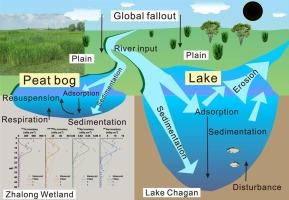Vertical distribution and migration mechanism of artificial radionuclides in Zhalong Wetland and Lake Chagan of the Nenjiang river basin
IF 5.7
1区 农林科学
Q1 GEOSCIENCES, MULTIDISCIPLINARY
引用次数: 0
Abstract
Peat bog (Zhalong Wetland) and lake (Lake Chagan) sediments were collected in the same watershed (∼200 km) to examine the mechanisms of artificial radionuclide deposition and transport. Plutonium(Pu)-239,240, neptunium(Np)-237, and americium(Am)-241 in sediments were analyzed by sector-field inductively coupled plasma mass spectrometry (SF-ICP- MS). Cesium(Cs)-137 was analyzed using an anti-Compton γ-ray spectrometer (HPGe). The results of 240Pu/239Pu atomic ratios, 237Np/239Pu atomic ratios, and 241Am/239+240Pu activity ratios showed that 137Cs, 239+240Pu, 237Np, and 241Am in Zhalong Wetland and Lake Chagan were mainly from global fallout. The activities of 137Cs, 239+240Pu, 237Np, and 241Am in Zhalong Wetland sediments are 0.3–41, 0.040–2.8, (0.016–2.9) × 10−3, and 0.02–0.66 mBq g−1, respectively. Relatively lower concentrations were found in Lake Chagan sediments, with 0.5–4.4, 0.046–0.217, (0.074–0.53) × 10−3, and 0.02–0.08 mBq g−1. Vertical distribution characteristics of the ZL2 core from Zhalong Wetland demonstrate that 239+240Pu, 237Np, and 241Am are affected by sediment suspension redistribution and organic matter redistribution. Besides, the inventories of 137Cs, 239+240Pu, 237Np, and 241Am in Lake Chagan sediments were 932 ± 33, 52 ± 2, 0.9 ± 0.01, and 19 ± 1 Bq m−2, respectively, which were lower than the mean values reported by IAEA at 40-50°N. These radionuclides show more positive depositional effects in wetland sediments. Calculations indicate that riverine inputs of 137Cs and 239+240Pu to the wetland are approximately 36–65 %, in addition to direct global deposition. In addition, the convection/dispersion phenomena of wetland sediment radionuclides were characterized using the convection-dispersion equation (CDE) model. The results of fitting the CDE model indicate that in Zhalong Wetland, the dispersion process dominates for 239+240Pu, 237Np and 241Am, while the deposition process for 137Cs. The CDE model revealed that 137Cs can be detected in sediments 100 years, suggesting that the environmental impacts of radionuclides with longer half-lives, such as 239+240Pu, 237Np, and 241Am, are likely to persist for an extended period.

嫩江流域扎龙湿地和查干湖人工放射性核素垂直分布及迁移机制
收集了同一流域(~ 200 km)泥炭沼泽(扎龙湿地)和湖泊(查干湖)沉积物,探讨了人工放射性核素的沉积和输送机制。采用扇形场电感耦合等离子体质谱(SF-ICP- MS)分析了沉积物中的钚(Pu)-239,240、镎(Np)-237和镅(Am)-241。用反康普顿γ射线谱仪(HPGe)对铯(Cs)-137进行了分析。240Pu/239Pu原子比、237Np/239Pu原子比和241Am/239+240Pu活度比结果表明,扎龙湿地和查干湖中的137Cs、239+240Pu、237Np和241Am主要来自全球沉降。扎龙湿地沉积物中137Cs、239+240Pu、237Np和241Am的活度分别为0.3 ~ 41、0.040 ~ 2.8、(0.016 ~ 2.9)× 10−3和0.02 ~ 0.66 mBq g−1。查干湖沉积物的浓度相对较低,分别为0.5 ~ 4.4、0.046 ~ 0.217、(0.074 ~ 0.53)× 10−3和0.02 ~ 0.08 mBq g−1。扎龙湿地ZL2岩心的垂直分布特征表明,239+240Pu、237Np和241Am受沉积物悬浮再分布和有机质再分布的影响。查干湖沉积物中137Cs、239+240Pu、237Np和241Am的库存分别为932±33、52±2、0.9±0.01和19±1 Bq m−2,低于IAEA在40-50°N的平均值。这些放射性核素在湿地沉积物中表现出更积极的沉积作用。计算表明,除了全球直接沉积外,137Cs和239+240Pu对湿地的河流输入约为36 - 65%。此外,利用对流-弥散方程(CDE)模型对湿地沉积物放射性核素的对流/弥散现象进行了表征。CDE模型拟合结果表明,扎龙湿地以239+240Pu、237Np和241Am的弥散过程为主,而以137Cs的沉积过程为主。CDE模型显示,137Cs可以在沉积物中检测到100年,这表明半衰期较长的放射性核素,如239+240Pu, 237Np和241Am,对环境的影响可能会持续很长一段时间。
本文章由计算机程序翻译,如有差异,请以英文原文为准。
求助全文
约1分钟内获得全文
求助全文
来源期刊

Catena
环境科学-地球科学综合
CiteScore
10.50
自引率
9.70%
发文量
816
审稿时长
54 days
期刊介绍:
Catena publishes papers describing original field and laboratory investigations and reviews on geoecology and landscape evolution with emphasis on interdisciplinary aspects of soil science, hydrology and geomorphology. It aims to disseminate new knowledge and foster better understanding of the physical environment, of evolutionary sequences that have resulted in past and current landscapes, and of the natural processes that are likely to determine the fate of our terrestrial environment.
Papers within any one of the above topics are welcome provided they are of sufficiently wide interest and relevance.
 求助内容:
求助内容: 应助结果提醒方式:
应助结果提醒方式:


